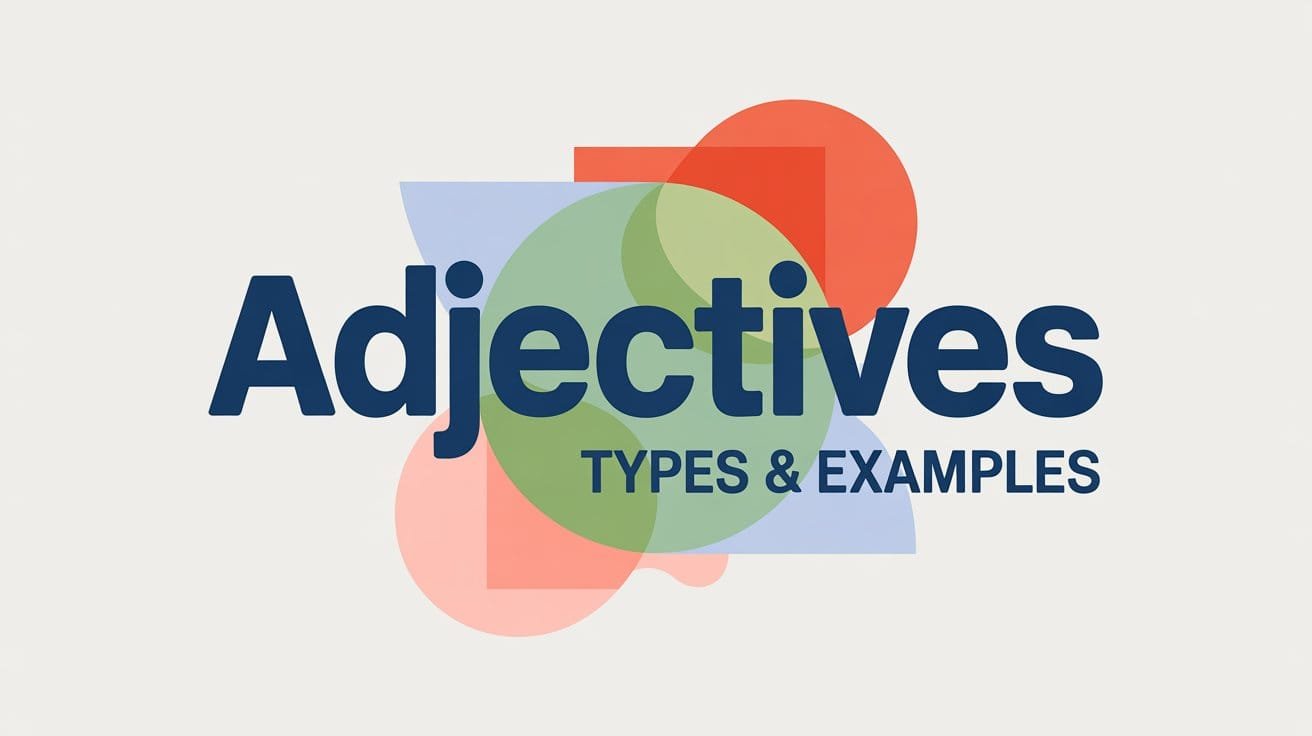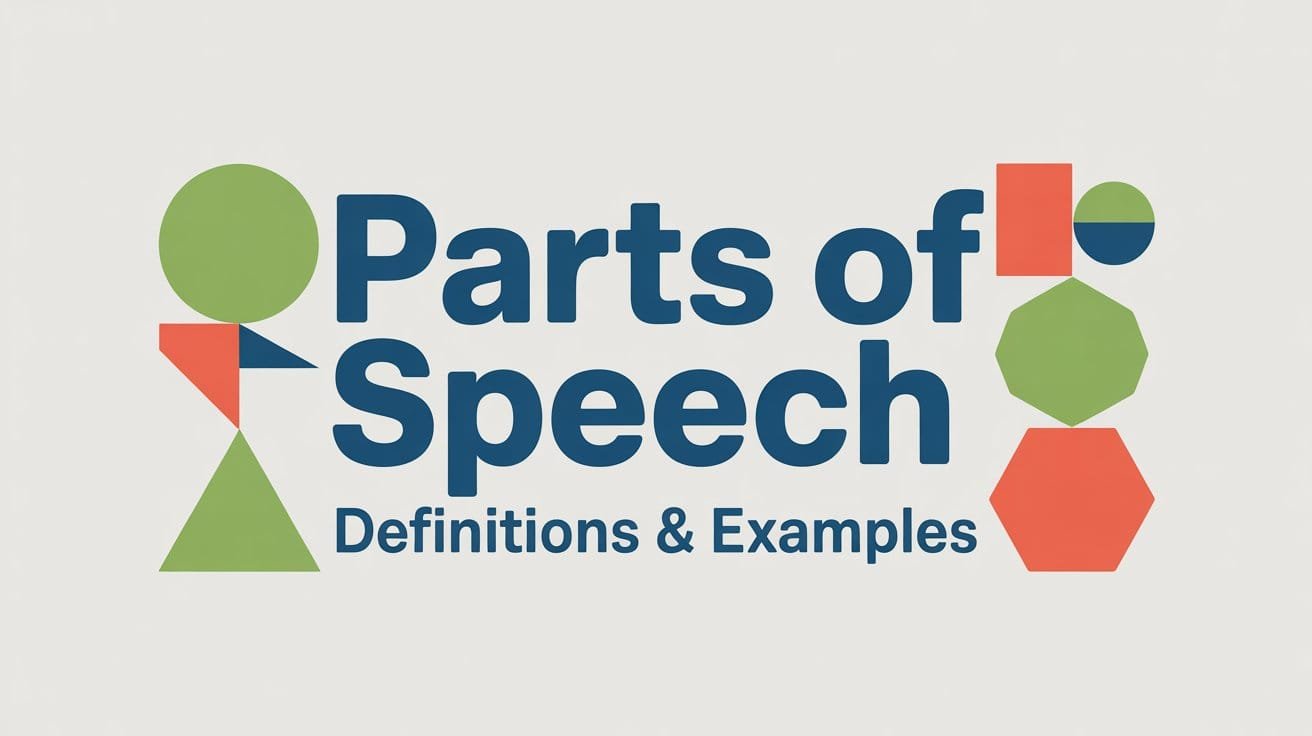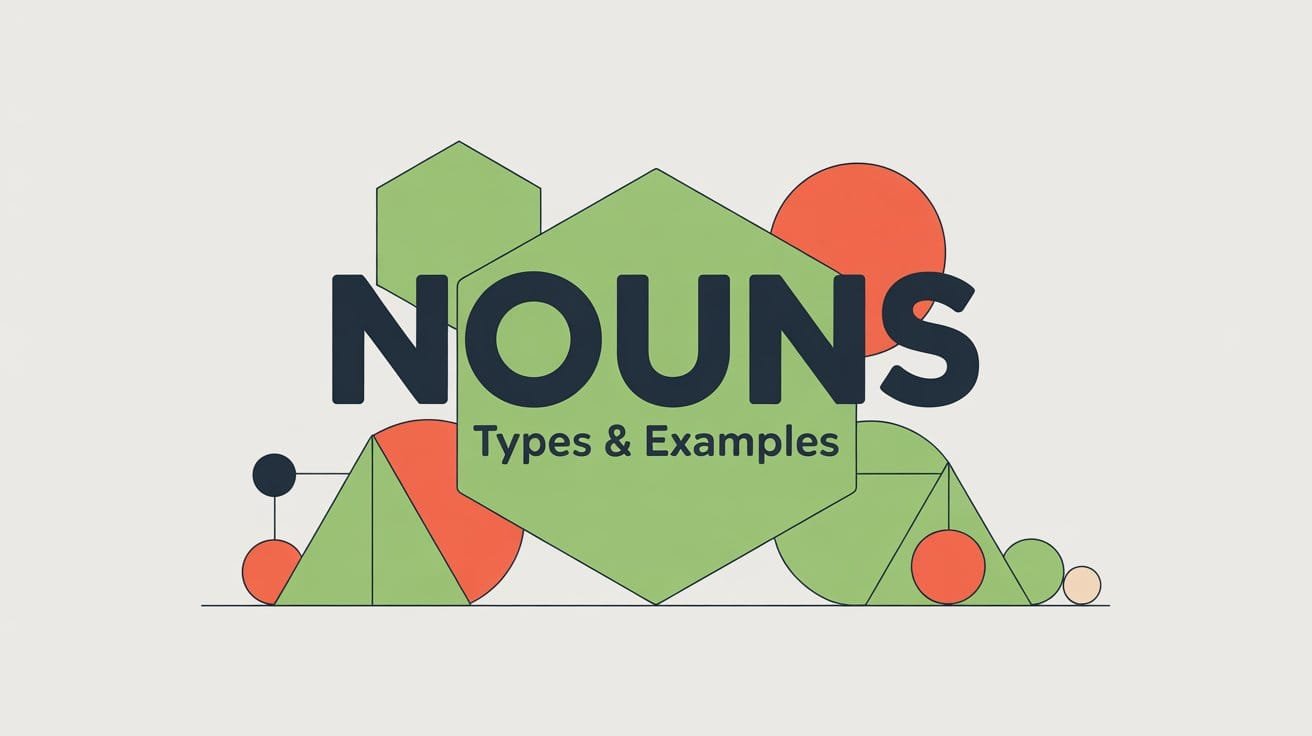Adjectives are words that describe or give more information about nouns and pronouns. They help us answer questions like What kind? How many? or Which one?
Without adjectives, our sentences would be flat and unclear. For example, instead of saying a book, we can say a heavy book, a fascinating book, or a red book; each phrase tells us something different and more specific.
What Is an Adjective?
An adjective is a word that describes or modifies a noun or a pronoun. It tells us more about a person, place, thing, or idea by highlighting details like size, shape, color, amount, or opinion.
In simple terms, adjectives help answer questions like:
- What kind? (e.g., gritty story)
- How many? (e.g., six volunteers)
- Which one? (e.g., those sneakers)
Examples:
- She handed me a crumpled note torn from her sketchbook.
- The café served three different types of herbal tea.
- He wore a burnt-orange scarf that stood out in the crowd.
- That was an unexpected outcome.
Adjectives usually appear right before the noun they describe, but they can also follow linking verbs like is, seems, or feels, especially when making a statement or giving feedback.
Why Are Adjectives Important in English?
Adjectives are one of the parts of speech that play a big role in making your language more precise and engaging. They give extra meaning to your sentences by narrowing down what you’re talking about. Without adjectives, most sentences would feel vague or incomplete.
Compare these two sentences:
- We stayed at a hotel.
- We stayed at a quiet lakeside hotel with wooden balconies.
The second sentence helps the reader picture the setting more clearly. Adjectives allow you to express opinions, add detail, and distinguish between similar things.
They’re also essential in both speaking and writing—whether you’re describing how something looks, sharing your opinion, or giving clear instructions.
More examples:
- She gave a detailed explanation that cleared up all the confusion.
- Please bring two large reusable bags for the groceries.
- That’s an awkward way to phrase it—try something simpler.
Types of Adjectives
Adjectives are grouped into several categories based on what they describe and how they function. Here’s a quick overview of the most common types you’ll encounter in English:
Descriptive Adjectives
Descriptive adjectives give details about the quality, condition, or characteristics of a noun.
Example: The dusty shelves hadn’t been touched in years.
Quantitative Adjectives
Quantitative adjectives express how much or how many.
Example: We needed several extra chairs for the guests.
Demonstrative Adjectives
Demonstrative adjectives point out specific nouns. The main ones are this, that, these, and those.
Example: Can you hand me that screwdriver on the shelf?
Possessive Adjectives
Possessive adjectives show ownership or belonging. These include my, your, his, her, its, our, and their.
Example: I left my phone on the kitchen counter.
Interrogative Adjectives
Interrogative adjectives are used to ask questions about nouns. The common ones are what, which, and whose.
Example: Whose notebook is this on the table?
Distributive Adjectives
Distributive adjectives refer to individual items or people within a group.
Example: Each contestant had a different approach to the challenge.
Proper Adjectives
Proper adjectives are formed from proper nouns and are always capitalized.
Example: They watched an old Italian film with subtitles.
Compound Adjectives
Compound adjectives combine two or more words (often hyphenated) to describe a noun more precisely.
Example: It was a last-minute decision to cancel the show.
Position of Adjectives in a Sentence
Adjectives can appear in different places depending on how they’re used. In English, adjectives generally come in two main positions:
Attributive Position (Before the Noun)
This is the most common placement. The adjective appears directly before the noun it describes.
Examples:
- They adopted a timid puppy from the shelter.
- He wore a charcoal-gray suit to the meeting.
- She scribbled on a blank postcard she found in the drawer.
Predicative Position (After a Linking Verb)
In this case, the adjective follows a linking verb like is, seems, becomes, or feels, and it describes the subject.
Examples:
- The garden looks overgrown after the rain.
- Her idea was brilliant and well thought out.
- He seems confident about the results.
Some adjectives can only be used in one of these positions, but most can appear in both, depending on the sentence structure.
Degrees of Comparison in Adjectives
Adjectives can show different levels of intensity or comparison. These are called degrees of comparison, and there are three main forms:
Positive Degree
Positive degree is the base form of the adjective. It simply describes a quality without comparing.
Examples:
- It’s a calm evening.
- He gave a genuine apology.
Comparative Degree
Comparative degree is used to compare two things. For most one-syllable and some two-syllable adjectives, add -er. For longer adjectives, use more or less.
Examples:
- Her handwriting is neater than mine.
- This route is more scenic than the highway.
- His explanation was less confusing than the first one.
Superlative Degree
The superlative degree is used to compare three or more things, showing the highest or lowest degree. Most short adjectives add -est, while longer ones use most or least.
Examples:
- That was the coldest night of the month.
- She’s the most organized person on the team.
- It was the least stressful option available.
Notes on Irregular Forms:
Some adjectives don’t follow standard rules.
| Positive | Comparative | Superlative |
|---|---|---|
| good | better | best |
| bad | worse | worst |
| far | farther/further | farthest/furthest |
| little | less | least |
| many | more | most |
Understanding degrees of comparison helps you describe differences more precisely, especially in writing and storytelling.
Participial Adjectives
Participial adjectives are formed from present or past participles of verbs and are used to describe nouns. These adjectives often express how someone feels (past participle) or what causes the feeling (present participle).
For example:
- The exhausted player sat quietly after the match.
- The exhausting schedule left little time for rest.
In the first sentence, exhausted describes how the player feels. In the second, exhausting describes the nature of the schedule. This subtle difference in meaning makes participial adjectives useful for adding precision to your writing.
These adjectives can describe emotions, reactions, or qualities:
- amused vs. amusing
- bored vs. boring
- confused vs. confusing
Using them correctly depends on what you’re describing—whether it’s the person experiencing something or the thing causing the feeling.
Common Examples of Adjectives
Adjectives appear in all kinds of everyday language. Below is a set of useful adjectives organized by category to help you see how they work in context.
Adjectives of Size
- tiny
- massive
- narrow
- oversized
Example: He squeezed into a narrow parking spot between two trucks.
Adjectives of Shape
- circular
- jagged
- rectangular
- uneven
Example: The artist painted on an irregular canvas made from driftwood.
Adjectives of Color
- golden
- emerald
- pale
- charcoal
Example: She wore a charcoal coat with silver buttons.
Adjectives of Age
- antique
- youthful
- ancient
- brand-new
Example: They restored an antique lamp found in the attic.
Adjectives of Emotion or Opinion
- curious
- dull
- brilliant
- annoying
Example: It was a brilliant solution to a long-standing issue.
Adjectives of Origin or Material
- wooden
- Italian
- silk
- tropical
Example: We bought a tropical plant that thrives in low light.
How to Identify an Adjective in a Sentence
To identify an adjective, ask yourself:
Does this word tell me more about a noun or a pronoun?
If it describes what kind, how many, or which one, it’s likely an adjective.
Here are some quick ways to spot adjectives:
Look Before the Noun
Most adjectives come right before the noun they describe.
Example: He took a long route through the hills.
(“Long” describes the noun “route.”)
Look After a Linking Verb
Adjectives often follow verbs like is, seems, looks, or feels and describe the subject.
Example: The soup smells spicy.
(“Spicy” describes “soup.”)
Ask the Right Questions
Try asking:
- What kind? → a frozen lake
- How many? → two options remain
- Which one? → that jacket is mine
Test with a Noun
If removing the word makes the noun more general or less clear, the word was likely an adjective.
Example:
Without adjective: She adopted a cat.
With adjective: She adopted a timid cat.
(“Timid” adds a descriptive detail.)
Common Mistakes with Adjectives
Even experienced English learners can run into trouble with adjectives. Here are some of the most frequent issues to watch out for, along with ways to avoid them:
Confusing Adjectives with Adverbs
Adjectives describe nouns, while adverbs describe verbs, adjectives, or other adverbs. Using the wrong one can make a sentence sound off.
Incorrect: She sings beautiful.
Correct: She sings beautifully.
(“Beautifully” describes how she sings, so it needs to be an adverb.)
Read: Adjective vs. Adverb
Misplacing Adjectives
When adjectives are too far from the nouns they modify, the sentence becomes unclear.
Incorrect: He gave a speech to the crowd about climate change that was inspiring.
Correct: He gave an inspiring speech to the crowd about climate change.
(The revised sentence makes it clear that the speech is inspiring, not climate change.)
Overusing Vague Adjectives
Words like nice, good, or bad don’t add much meaning. Try using more specific adjectives that match your intent.
Weak: It was a nice experience.
Improved: It was a rewarding experience after weeks of preparation.
Incorrect Comparison Forms
Using the wrong form for comparatives and superlatives can sound unnatural or incorrect.
Incorrect: This problem is more easier to solve than the last one.
Correct: This problem is easier to solve than the last one.
FAQs About Adjectives
What is the easiest way to understand adjectives?
Adjectives are words that give more detail about a noun or pronoun. If a word answers questions like what kind, how many, or which one about a noun, it’s likely an adjective.
Can adjectives describe pronouns?
Yes, in some cases. For example: She felt confident—the adjective “confident” describes the pronoun “she.” This usually happens when adjectives follow linking verbs.
Are all describing words adjectives?
Not always. While many describing words are adjectives, some may be adverbs or even participles. For example, in She runs quickly, “quickly” is an adverb, not an adjective.
What are the 10 most common adjectives in English?
Here’s a list of frequently used adjectives in everyday conversation:
good
bad
new
old
big
small
happy
early
long
great



